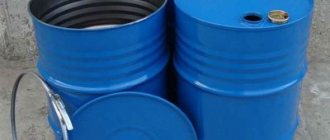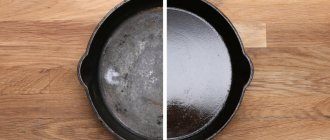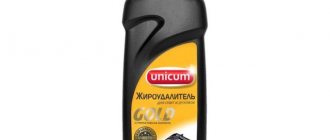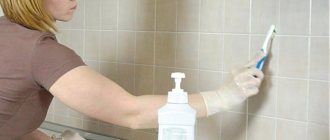Modern deep fryers use removable Teflon-coated bowls. Along with these, many housewives also have old deep fryers - the bowl in them cannot be removed, and it is not so easy to wash it. Let's look at both options. After using the deep fryer, hot oil and grease accumulate on the walls, which requires cleaning. This process is quite labor-intensive, since cleaning a fryer from old oil at home is a tedious and dirty job. Cleaning should be done as needed.
If the deep fryer is used at home only occasionally, then it will not be difficult to wash it of old oil if you clean it after each use.
If you use this equipment frequently, it is enough to change the oil regularly and clean it thoroughly after a few days. Otherwise, the fat on the inside surface of the fryer turns into a dark coating that is difficult to remove.
Cleaning process for a deep fryer with a removable bowl
Many manufacturers produce electrical appliances in which the lid and inner bowl are removable. This makes the cleaning process much easier.
The electrical appliance should not be washed under a water tap or in a dishwasher, so as not to cause a short circuit and further damage to the appliance.
Before cleaning the fryer, unplug it and wait until it cools completely, as hot oil can cause serious burns. Water getting into a container with hot fat is especially dangerous.
Deep fryer with removable Teflon bowl.
After the fryer has finished operating, you must wait until the inner container has completely cooled down and remove the bowl. If there are burnt food residues in the bowl, under no circumstances scrub them with a hard brush or knife - you will ruin the Teflon. How to clean a deep fryer:
- Wipe the inside of the deep fryer bowl with a damp cloth to remove any burnt-on frying residue. Remove stuck fragments with a silicone scraper. Caution is required as vigorous movements may damage the non-stick surface of the fryer.
- To easily wash off burnt oil, fill the bowl with hot water, add a drop of dishwashing gel and leave to stand for several hours.
- Instead of dish gel, you can pour 2 tablespoons of 9% vinegar into the bowl. After this time, wash the bowl with soapy water.
- The resulting limescale deposits on the walls of the fryer bowl can be easily washed by wiping its surface with a sponge soaked in a 5% vinegar solution, and then removing any remaining scale with a paper towel.
Used oil can be reused by draining it into a separate container with a lid and storing it in the refrigerator. If you want to dispose of used fat, it should be placed in a sealed container and thrown into the trash. Under no circumstances should oily waste be poured down the drain, as this will clog the drain pipes. The food basket, removed from the appliance, is washed in the sink. You should first moisten it with water, wipe it with a sponge with a few drops of dishwashing detergent and leave it for a while to dry.
Recommendations
To successfully clean the fryer from old oil and not damage the non-removable bowl, you need to remember several rules:
- Do not use metal sponges, scrapers or hard brushes for cleaning. They will damage the non-stick coating, and as a result, grease will accumulate in the cracks after each use of the device.
- The deep fryer can only be cleaned with gel products or liquid solutions. Powders cannot be used; they also scratch the coating of a fixed or removable bowl.
It is strictly forbidden to try to wash the unit with technical solvents, gasoline, acids and other toxic substances. The old fat will disappear without a trace, but the device will be unsuitable for food use.
Cleaning a deep fryer with a fixed bowl
If you have a deep fryer with a bowl that cannot be removed, then you need to wash it a little differently.
- First, drain all the fat from the container, then wipe off the remaining fat with a paper towel or an unnecessary rag. A sponge will not help here, as it will only smear the oil. Wiping begins from the bottom, then the walls are cleaned in a circular motion.
- After this, you should pour heated water from a kettle or tap into it, add a drop of dishwashing gel and wait.
- After 30 minutes, you can proceed to the next cleaning step. The water must be heated directly in the deep fryer by connecting the device to the mains. If severe contamination is present, the water is boiled for several minutes.
- Drain the water and wipe the fryer container dry with a paper towel or rag.
- If there are traces of oil left, pour water into a bowl, add 1-2 tablespoons of vinegar and boil for 5 minutes. Then drain the water and dry the bowl.
- Old grease will be removed from the walls of the deep fryer by boiling water with grated laundry soap. Boil for 15-20 minutes.
- Another way to get rid of baked-on grease is to combine baking soda and vinegar and pour the fizz into a fryer with water and bring to a boil.
A deep fryer in which the bowl cannot be removed.
After unplugging, the fryer basket can be dipped in and out of hot water several times. To make it easier to wash, you can additionally add detergent to the water. Use a kitchen brush to wipe away an old stain of dried grease from the basket. After this, it should be held under a tap with running water to wash it from the soapy solution, wipe it dry with a towel or dry it in a dryer for clean dishes.
How to clean different types of filters?
In addition to caring for the bowl, heating element, and outer surface of the device, cleaning the filters is also very important. Filters are usually located in the lid of the device. They are removable, non-removable, foam rubber, carbon. The type of filter can be found in the instructions for use. Often it will also tell you how to clean it properly.
Removable carbon filter
Foam filters are the easiest to clean. To clean such a filter, you need to remove it from the device cover, wash it with detergent and leave it to dry for a couple of hours. This type is extremely convenient as it does not require additional costs.
Removable carbon filter
Carbon filters fight unpleasant odors. They retain the smell within themselves. This type is not intended for cleaning and washing; the old filter must be disposed of and purchased a new one. This filter lasts for quite a long time (35 preparations) and the price of a new one is low.
The methods described above are suitable for removable filters. If the filter is not removable, then under no circumstances should the lid be dipped into a soapy solution or under running water. You need to do the following:
- Wipe the filter with a damp cloth,
- Wipe with a cloth and detergent,
- Wash off the detergent from the filter with a clean cloth.
- Wipe the filter dry.
You can also buy oil filters. This filter is convenient to use so as not to change the oil very often. It helps to strain out the old oil, since after several uses it may have an unpleasant smell and taste.
Cleaning Industrial Fryers
Industrial appliances can be washed using special kitchen brushes with soft bristles and a long handle. If deep fryers are used frequently in restaurants, the oil should be filtered 1 or 2 times a day. As soon as the oil develops an unpleasant bitter odor when heated, it should be replaced completely.
After draining the oil, the internal surfaces must be cleaned of food residues. Cleaning the outside and edges of the deep fryer not only improves its appearance, but also increases its service life. Apply detergent to such surfaces for a few minutes before washing, and then wipe off with a damp cloth after 10 minutes.
Once every six months, a deep fryer used for industrial purposes is cleaned by boiling. Boil the water collected in the frying container for at least 20 minutes with the addition of a special detergent. After washing and rinsing, you need to pour water and vinegar into the oil container, which will help completely remove soap residue.
Depending on the model of fryer you use, cleaning methods may vary. Therefore, before cleaning the deep fryer, you should read the instructions supplied with the appliance.
Nuances of operation
As for the oil used, it should be transparent. Turbidity is a sign that such fat cannot be used. The oil in the deep fryer should be changed after every eighth serving of food, and in the case of potatoes - after every twelfth.
Thrifty housewives are concerned about the question of what to do with the large amount of oil remaining after such frying. In models with filters it can be used in the second circle
: after the cleaning procedure, the oil is put back into use. The product is used twice as efficiently as its unfiltered counterpart
A little trick: for a regular model, you can buy a paper filter at any store and do the filtration yourself.
Many potential users are confused by the number of calories that are ultimately contained in the resulting dish. For such people, models that cook without oil
. This type of unit has another name - an air fryer. There is not even a bowl for oil: all the thermal effect on the food is carried out by the air circulating in a circle in the container. Fats are added in small portions directly to the product (for example, potatoes). That is, oil is still used here, but in very small doses.
Air fryer Tefal ActiFry FZ7072
Tips for Air Fryers with a Metal Bowl
These tips are not suitable for Teflon bowls!
- Burnt oil stains that cannot be washed off with liquid detergent can be cleaned with a damp sponge sprinkled with baking soda.
- Abrasive detergents are used only as a last resort. After this treatment, thoroughly rinse the fryer parts to completely remove any remaining chemicals. After rinsing the bowl, you should fill it again with water and run your hand along the bottom and walls in order to determine the quality of washing. If traces of a fatty film are visible on the surface of the water, then you should pour 50 grams of vinegar into it.
- Make sure the fryer is completely dry before using it again. Accessible parts can be wiped with a towel; the remaining elements should be dried naturally.
- Do not wash an electrical appliance that is plugged in.
- Do not completely immerse the fryer in water.
- If the bowl is made of stainless steel, then simply wash it with hot water, using a soft sponge and any detergent.
Some subtleties
There are a few things you need to know before you start cleaning your deep fryer:
- It is unacceptable to use brushes with hard bristles or sponges made of metal. They can be useful for working with rough cast iron skillets. They should not be used to clean non-stick cookware. Such brushes lead to the formation of scratches and cracks in which oil will constantly collect and constantly burn.
- There is no need to use traditional methods and clean the deep fryer using soda or cleaning powders. Such products damage the surface of the bowl.
- Scrapers must not be used.
We figured out how you can’t and what you shouldn’t use when cleaning this device. Now we can move on to the question of how to clean it.
Clean the outside of the equipment
Once the inside is completely cleaned, you need to start cleaning the outer casing.
Usually, during cooking, drops of sunflower oil fall on it, so it is important to degrease the body, eliminating fat deposits
You can use a sponge, hot water, dishwashing liquid, or a mild degreaser to clean the outside of the fryer. But first it is recommended to study the instructions from the manufacturer, which tell you what material the device is made of. A degreaser is not always suitable for the body, so you have to limit yourself to only liquid intended for washing dishes.
Some parts can be wetted, but others will need to be protected from moisture.
Therefore, it is important to initially determine the correctness of the process so as not to cause serious harm to the equipment. Work is carried out only after the equipment is disconnected from electricity, so it is important to follow safety rules
If the outside of the deep fryer is very dirty, you will have to use a degreaser designed for cleaning ovens, but first check that it does not harm the coating.
Normal pollution
When the oil in the vessel has stood for no more than two days, then a normal dishwashing detergent will cope with the stains. You just need to fill the container with boiling water several times - pour it, let the water cool, pour it out. Usually two changes of water are enough, but if necessary, more is possible. After this, wipe off the softened fat with a dry soft cloth and apply detergent to the walls of the bowl. After all this has been done, remove the oil again with a dry cloth and wash the bowl until completely clean.
- Tip 1:
grease should be wiped off with a cloth - a special kitchen cloth, an ordinary piece of cloth or a thick paper towel. It is not recommended to use porous sponges, as they are less effective in this case.- Tip 2:
it is better to prefer thicker liquid dishwashing detergents or use special washing gels.











